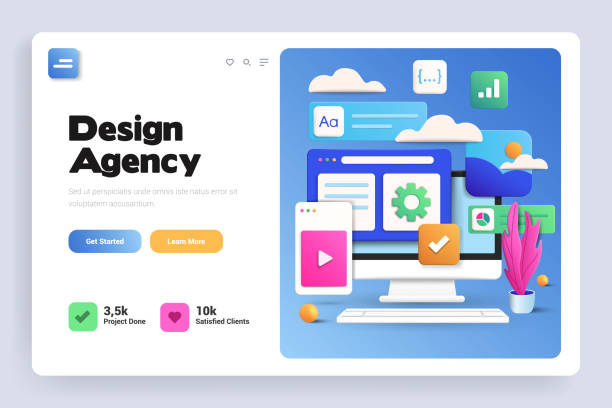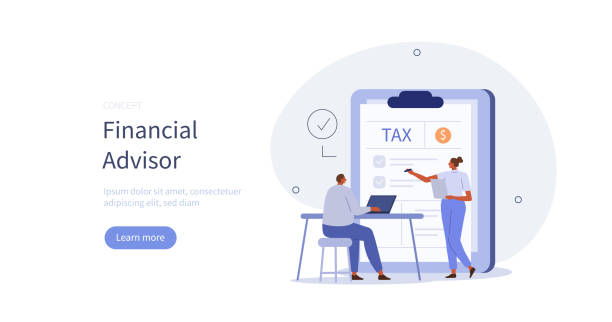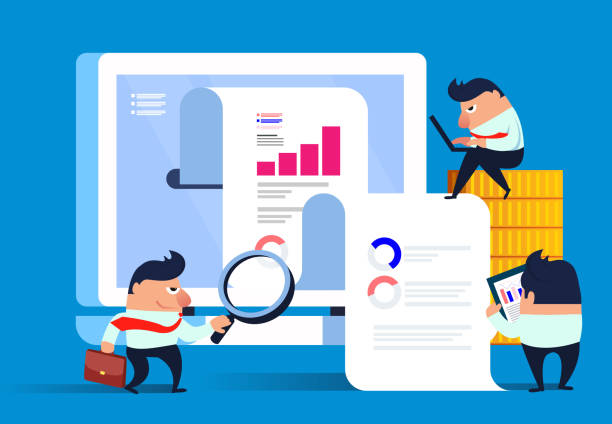Introduction to SEO-Optimized Website Design and Its Importance

In today’s digital world, having a website is not just an online presence; it’s an investment in the future of your business.
However, simply having a website isn’t enough; your website needs to be seen.
This is where the importance of #SEO-optimized website design reveals itself.
SEO (Search Engine Optimization) is a process that helps your website achieve a higher ranking in the search results of Google, Bing, and other engines, making it visible to more audiences.
The goal of this section is to provide a comprehensive explanation of why this type of design is crucial for any online business.
An SEO-optimized website design goes beyond visual aesthetics; it includes a powerful technical structure, relevant content, and an optimized user experience, all of which are essential for attracting and retaining visitors.
This approach helps you attract more organic traffic, which has higher stability and return on investment compared to paid traffic.
When a website is designed with SEO principles, search engines can more easily understand its content and recommend it to relevant users.
This educational process shows you how to build a website that is not only beautiful but also effective in attracting new customers by adhering to technical and content standards.
Ignoring SEO during web design can mean wasted investment and lost business opportunities, because without visibility, even the best content and services won’t reach the audience.
Therefore, you should think about proper SEO implementation from the very beginning.
In fact, investing in SEO-optimized website design is an investment in your long-term online success.
Are you dissatisfied with the low sales of your online store?
Rasawab is your solution for a professional and high-selling online store.
✅ Significant increase in sales and revenue
✅ Easy and enjoyable shopping experience for customers
⚡ Get a free consultation from Rasawab now!
Key Technical Elements in SEO-Optimized Website Design

To achieve an #SEO-optimized website design, understanding and correctly implementing technical elements is crucial.
This section specifically examines the infrastructures that search engines consider when ranking your website.
The first and most important element is site loading speed.
Websites that load quickly provide a better user experience and are preferred by Google.
Using image compression, browser caching, and minimizing code are among the methods to increase speed.
The second element is an optimized and hierarchical URL structure.
Short, descriptive, and keyword-rich URLs help search engines better understand page content.
Third, the use of XML Sitemap and robots.txt file.
The sitemap tells search engines which pages should be indexed, while robots.txt restricts access to unnecessary pages.
These two elements are search engine guidance tools.
Fourth, correctly implementing Canonical tags to prevent duplicate content.
This tag tells Google which version of a page is the original and prevents the site from being penalized for duplicate content.
Fifth, using Structured Data (Schema Markup) helps search engines understand your website’s content in more detail and display it as Rich Snippets in search results.
This section provides comprehensive guidance to ensure that your website’s technical infrastructure is optimized for SEO.
Also, ensuring that your website is properly hosted and uses an SSL certificate (HTTPS) is a fundamental security and SEO principle that affects your ranking.
Adhering to these technical points from the ground up is essential for an SEO-optimized website design and gives your website a strong competitive edge in the online space.
Keyword Research and Content Strategy in SEO Design

One of the main pillars in #SEO-optimized website design is comprehensive and accurate keyword research.
This process forms the foundation of your content strategy and helps you understand exactly what your target audience is looking for and what phrases they use to search.
This section analytically addresses the importance of keywords and how to integrate them into website content.
Identifying relevant and high-volume keywords, but with less competition, allows you to gain a good ranking in search results by producing valuable content around those keywords.
Using tools like Google Keyword Planner, Ahrefs, Semrush, and Moz is essential for finding keyword ideas, analyzing competitors, and checking search volume.
After identifying primary and secondary keywords, it’s time to plan your content strategy.
Producing high-quality and valuable content that answers user questions and meets their needs is of utmost importance.
Content should be long, comprehensive, and accurate, yet readable and engaging.
This approach is educational for anyone who wants to produce content capable of attracting high traffic.
Placing keywords naturally in the title, meta descriptions, headings (H1, H2, H3), and in the body of the text is a principle of content optimization.
Also, diversity in content format – such as articles, videos, infographics, and podcasts – can help attract a wider range of audiences.
The content strategy should be continuously updated to keep pace with changes in search engine algorithms and user needs.
Ultimately, it should be remembered that the main goal of this section is to help you in designing an SEO-optimized website that is not only technically optimized but also provides rich and engaging content that leads to attracting audiences and converting them into customers.
| Keyword Type | Description | Example |
|---|---|---|
| Short-tail Keywords | General and highly competitive, high search volume, ambiguous user intent | “SEO”, “Marketing” |
| Mid-tail Keywords | Intermediate, less competitive than short-tail, relatively clearer user intent | “SEO Website Training”, “Digital Marketing Consultation” |
| Long-tail Keywords | Specific and less competitive, lower search volume, very specific user intent close to purchase | “Best Method for SEO-Optimized Website Design for Online Clothing Store” |
| Local Keywords | Includes specific location name, for local businesses | “SEO-Optimized Website Design in Tehran” |
The Importance of User Experience (UX) in SEO-Optimized Website Design

In recent years, search engines have increasingly emphasized #User Experience (UX) as a critical ranking factor.
An #SEO-optimized website design is no longer limited to keywords and links; it involves providing a flawless and satisfying experience to visitors.
This section explains the close relationship between UX and SEO.
When users are satisfied with your website, they spend more time on it (Time on Site), view more pages (Pages per Session), and the bounce rate decreases.
These signals indicate to search engines that your website has valuable and relevant content that keeps users satisfied, ultimately helping to improve your ranking.
Good UX includes attractive visual design, easy and intuitive navigation, high loading speed, and compatibility with various devices (responsiveness).
Clear and logical navigation design helps users easily find what they are looking for and prevents confusion.
Using appropriate fonts and colors, high-quality images, and sufficient white space enhances content readability.
Additionally, contact forms, call-to-action (CTA) buttons, and purchasing processes should be simple and straightforward so that users can easily achieve their goals.
This section provides guidance on how to build a website that is not only technically optimized for SEO but ultimately also has a higher conversion rate, by focusing on user needs and expectations.
Google continuously improves its algorithms to better understand user experience, so investing in UX is a direct investment in your SEO and overall online success.
Ignoring user experience, even with strong technical SEO, can lead to a high bounce rate and ultimately a drop in search engine rankings.
Therefore, UX should be considered an inseparable part of the SEO-optimized website design process.
Are you falling behind in the competition with large online stores?
Rasawab, with professional online store design, brings your business online and increases your market share!
✅ Increase brand credibility and customer trust
✅ Easy shopping experience leading to more sales
⚡ Act now to get a free website design consultation!
Mobile-First Indexing and Responsive Design

In an era where most searches are conducted via mobile devices, Mobile-First Indexing by Google has become a #primary priority in #SEO-optimized website design.
This section informatively and expertly discusses the importance of Responsive Design and its impact on SEO.
Google has gradually moved towards mobile-first indexing since 2018, meaning it considers the mobile version of your website as the primary version for indexing and ranking.
Therefore, if your website provides a poor user experience on mobile, even if its desktop version is excellent, your SEO ranking will suffer.
Responsive design is a web design approach that enables your website to automatically adapt to the user’s screen size (mobile, tablet, desktop).
This means you don’t need to have separate versions for each device, which makes management and SEO much simpler.
Key benefits of responsive design for SEO-optimized website design include: a single URL that prevents duplicate content issues, improved user experience across all devices, reduced bounce rate, and increased user time on site.
Google officially recommends responsive design as its preferred method for building mobile-friendly websites.
This is important guidance that every designer and website owner should heed.
Ensuring that images are properly optimized and load quickly on mobile devices, as well as using readable fonts and large clickable buttons for touchscreens, are important details in responsive design.
Ultimately, focusing on mobile-first indexing and correctly implementing responsive design is a fundamental step to ensure that your website is SEO-optimized and accessible to a wider audience.
Optimizing Site Speed and Website Performance

In today’s world, website speed not only directly impacts #user experience but is also recognized as a critical ranking factor in Google’s algorithms.
Therefore, optimizing site speed is a main pillar in #SEO-optimized website design.
This section provides guidance and specialized methods for improving website performance and speed.
Users expect web pages to load in less than 2-3 seconds, and if there’s a delay, they leave the website.
This early departure leads to an increased bounce rate and sends negative signals to search engines.
To increase speed, several key actions exist: optimizing images by compressing them without reducing quality and using next-generation formats (like WebP); minifying CSS, JavaScript, and HTML codes to remove empty spaces and extra characters; implementing browser caching to store website elements for subsequent user visits; and optimizing the server and choosing a high-quality, high-speed hosting.
Using a Content Delivery Network (CDN) can also significantly improve website loading speed for users in different geographical locations.
Tools like Google PageSpeed Insights, GTmetrix, and Pingdom Tools help you identify your website’s weaknesses in terms of speed and receive solutions for improving them.
This process provides a precise analysis of your website’s performance.
A fast and optimized website not only improves user experience but also increases your chances of ranking higher in search results and directly contributes to success in building an SEO-driven website.
Ignoring site speed can mean losing traffic and revenue, even if your content is highly valuable.
Therefore, website performance optimization should be considered at every stage of SEO-optimized website design.
Link Building and Off-Page SEO to Boost Rankings

#Link Building and Off-Page SEO are crucial factors in search engine rankings that complement your #SEO-optimized website design (On-Page SEO).
This section analytically explores effective link-building methods and strategies.
Links act as “votes of confidence” from other websites to yours.
The greater the number and quality of incoming links (Backlinks) to your site, the more credible and authoritative search engines consider it, and consequently, they grant you a better ranking.
However, quality precedes quantity; incoming links from reputable websites relevant to your industry are far more valuable than spammy or irrelevant links.
Link building strategies include: producing very high-quality and shareable content (Linkable Assets) that naturally attracts links; digital public relations and bringing your content to the attention of news and influential websites; guest blogging (writing articles for other websites and receiving a backlink); building relationships with influencers and requesting links; and broken link building on other websites.
These actions are educational for a deeper understanding of how to increase your domain authority.
In addition to link building, off-page SEO also includes activities such as social media engagement, acquiring positive user reviews, and presence in relevant online directories, all of which help improve your website’s visibility and credibility.
All these activities help strengthen your site’s credibility and authority and show search engines that your website is a reliable source.
A smart and sustainable link-building strategy is an integral part of any successful SEO-optimized website design that can put your website on a long-term growth trajectory.
| Strategy | Description | Benefits for SEO |
|---|---|---|
| Creating Linkable Content (Linkable Assets) | Creating valuable content such as infographics, statistical data, free tools that naturally attract links. | Attracting natural and high-quality links, increasing domain authority, improving ranking. |
| Guest Blogging | Writing articles for other websites in a related field and receiving a backlink. | Acquiring relevant links, increasing referral traffic, improving credibility. |
| Broken Link Building | Finding broken links on other websites and suggesting your content in their place. | Acquiring links from reputable websites, building relationships. |
| Social Media and Public Relations | Sharing content on social media, participating in relevant online communities. | Increasing brand awareness, attracting traffic, increasing visibility and link acquisition opportunities. |
Measuring SEO Success and Analytics Tools

After implementing an #SEO-optimized website design, the next step is continuous performance measurement and data analysis to ensure success.
This section provides an explanatory and guiding overview of key tools and important metrics for evaluating SEO campaigns.
Without data, you cannot understand what is working and what needs improvement.
Analytics tools such as Google Analytics and Google Search Console are essential for any SEO strategy.
Google Analytics provides valuable insights into website traffic, user behavior (such as bounce rate, time on site, pages visited), and traffic sources.
Google Search Console helps you view your website’s performance in Google search results, identify potential errors, check the indexing status of pages, and see which keywords are attracting traffic.
Key metrics for measuring SEO success include: Keyword Rankings, organic traffic volume, bounce rate, number of pages viewed per session, Conversion Rate, and SEO Return on Investment (ROI).
An increase in organic traffic indicates improved visibility of your website in search engines, while a decrease in bounce rate and an increase in time on site indicate relevant content and a good user experience.
These tools and metrics help you conduct a precise analysis of your website’s performance and make informed decisions for continuous improvement.
Remember that SEO is an ongoing process, and continuous monitoring and optimization are essential to maintain and improve rankings.
Effective use of these tools allows you to intelligently lead the way in SEO-optimized website design and surpass competitors.
Research shows that 80% of customers trust companies with professional websites more. Does your current site inspire this trust?
With Rasawab’s corporate website design services, solve the problem of lack of customer trust and a weak online image forever!
✅ Create a professional image and increase customer trust
✅ Attract more sales leads and grow your business
⚡ Get a free consultation
Common Mistakes in SEO-Optimized Website Design and Prevention Strategies

On the path to #SEO-optimized website design, there are common mistakes that can render your efforts fruitless and even harm your website’s ranking.
This section, presented as thought-provoking content, addresses these mistakes and expert solutions to prevent them.
Did you know that even a small mistake in coding or content strategy can jeopardize your entire SEO project? One of the biggest mistakes is ignoring high-quality and relevant content.
Many focus solely on technical optimization and forget that search engines ultimately aim to provide the best answers to user queries.
Thin, duplicate, or worthless content not only fails to satisfy users but is also penalized by Google’s algorithms.
Solution: Always focus on producing comprehensive, unique, and valuable content that fully addresses the needs of your audience.
Another mistake is excessive keyword usage (Keyword Stuffing).
Stuffing text with keywords unnaturally not only ruins the user experience but can also lead to your website being penalized by Google.
Solution: Use keywords naturally and in appropriate context, and also leverage synonyms and related keywords.
Disregarding website responsiveness (not being mobile-friendly) is also a fatal mistake, especially given Google’s mobile-first indexing.
Solution: Ensure your website displays correctly on all devices and provides a good user experience.
Spammy link building or buying links can also have serious consequences for your SEO ranking.
Solution: Always focus on natural link building through high-quality content.
Finally, ignoring site speed and security (HTTPS) are also common mistakes.
Solution: Continuously monitor and optimize your site speed and use an SSL certificate.
By being aware of these mistakes and implementing correct solutions, you can ensure the optimal optimization of your website for search engines and ultimately achieve a successful SEO-optimized website design.
The Future of SEO-Optimized Website Design and Emerging Trends

#The future of SEO-optimized website design is rapidly evolving, and with technological advancements and changes in user behavior, new trends are emerging that every web designer and SEO specialist should pay attention to.
This section, presented in an informative and entertaining way, addresses some of these emerging trends.
One of the most important future trends is Voice Search.
With the increasing use of voice assistants like Siri, Google Assistant, and Alexa, optimizing for voice search has become increasingly important.
This type of search is often more natural, longer, and conversational.
Therefore, producing content that directly and clearly answers user questions is crucial for this trend.
Another trend is Artificial Intelligence and Machine Learning in search engine algorithms.
Algorithms like Google’s RankBrain, BERT, and MUM use AI to better understand content and provide more relevant search results.
This means that the quality and depth of content will become even more important.
Core Web Vitals, which are metrics for measuring user experience (such as loading speed, interactivity, and visual stability), will also play a more prominent role in rankings in the future.
In addition, Visual Search and Augmented Reality also have great potential to change how users search.
Optimizing images with appropriate Alt tags and high-quality files becomes important in this regard.
Interactive and personalized content is another trend that will soon become a standard.
Finally, focusing on E-A-T (Expertise, Authoritativeness, Trustworthiness) will always be a fundamental factor.
Websites that establish themselves as authorities in their field of activity will continue to be more successful in the future.
By understanding and following these trends, you can ensure that your SEO-optimized website design remains advanced and competitive.
Frequently Asked Questions
| Question | Answer |
|---|---|
| What is an SEO-optimized website design? | It is a website designed to be optimized for both users and search engines to achieve higher rankings. This includes adhering to technical, content, and user experience principles. |
| Why is SEO important in website design? | The importance of SEO in website design is due to its ability to increase site visibility in search results, attract organic traffic, improve user experience, and enhance user trust and credibility. |
| What are the most important elements of SEO-friendly website design? | Responsiveness for mobile, high loading speed, clear navigation structure, correct use of heading tags (H1-H6), image optimization, and high-quality content. |
| What is the impact of responsiveness (mobile-friendliness) on SEO? | Google uses mobile-first indexing, meaning it prioritizes the mobile version of websites for ranking. Therefore, responsiveness is crucial for SEO. |
| What is the role of site speed in SEO? | Faster websites provide a better user experience, reduce bounce rate, and are favored by search engines. Site speed is one of Google’s ranking factors. |
| How to optimize images for SEO? | By compressing image sizes, using descriptive and relevant file names, and most importantly, writing appropriate Alt Text relevant to the content and keywords. |
| What is the importance of content in SEO-driven design? | High-quality, relevant, and keyword-rich content is crucial for attracting and engaging users, as well as for ranking in search engines. Content is king in SEO. |
| How does URL structure affect SEO? | Clean, descriptive, short, and keyword-rich URLs help users and search engines better understand page content and appear in search results. |
| What is Schema Markup and what is its role in SEO? | Schema Markup is structured data that helps search engines better understand site content and display it as Rich Snippets in search results, which increases click-through rate (CTR). |
| Should SEO be considered from the beginning of website design? | Yes, it is highly recommended. Integrating SEO principles from the initial phase of website design saves time and cost, and leads to better and more sustainable long-term results. |
And other services of Rasawab Advertising Agency in the field of advertising
Smart Reportage: A combination of creativity and technology for digital branding through optimizing key pages.
Smart Social Media: Designed for businesses seeking online growth through SEO-driven content strategy.
Smart SEO: A dedicated service for improving SEO rankings based on marketing automation.
Smart Direct Marketing: Professional optimization to increase sales using custom programming.
Smart Brand Identity: Transform campaign management with precise audience targeting.
And over a hundred other services in internet advertising, advertising consultation, and organizational solutions
Internet Advertising | Advertising Strategy | Advertorial
Resources
SEO-Optimized Website Design GuideComprehensive SEO GuideWebsite SEO OptimizationSEO-Friendly Website Design
? To elevate your business in the digital world and achieve peak visibility, Rasawab Afarin, an expert in digital marketing services including corporate website design, is your professional companion.
📍 Tehran, Mirdamad Street, next to Bank Markazi, Southern Kazeroon Alley, Ramin Alley, No. 6




